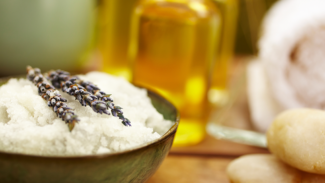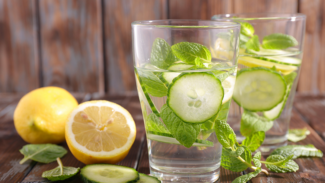Hiya Gorgeous,
Many of us still feel like that kid in the high school bathroom piling on concealer and foundation to hide a volcanic pimple before class. Except now, we’re at the office and have a presentation in front of 50 colleagues in about three minutes. Anyone who has struggled with skin issues knows that they can be stressful, frustrating and not-so-good for your confidence. We want long-term solutions, and we want them now!
If you’ve used topical remedies and prescriptions with the guidance of a reputable dermatologist and seen results—great! But, there are also some simple and natural solutions at your fingertips that may work in place of, or in combination with, topical solutions. And, these don’t have the side effects that can come with over-the-counter and prescription drugs.
Today, we’re going to explore some skin health practices that go beyond traditional approaches. We’ll tackle a few of the most common challenges: acne, sun damage and premature wrinkles. If something resonates with you, take it for a spin. You might be surprised at the improvements you see in the mirror and how great you feel on the inside. Win-win!
Best and Worst Foods and Habits for Acne
We often associate acne with puberty and our adolescent years but for some people, it continues to be an issue into adulthood. Let’s face it, pimples can be painful and frustrating. It’s no wonder that individuals with long-term acne tend to have higher rates of depression, anxiety and anger (study). If you’re one of these folks, food can be your ally.
For starters, the omega-3s in flax seeds, chia seeds and walnuts help decrease inflammation all over the body, including in the skin. Research has shown that eating omega-3s not only reduces the number, size and redness of pimples after 2 months but also eases symptoms of anxiety and depression (study). To get 1,000 milligrams of acne-easing omega-3s, have 2 teaspoons of ground flax seeds or chia seeds, or 7 walnut halves each day.
In addition, try adding Brazil nuts, sesame seeds and pumpkin seeds to your diet. Deficiencies of selenium and zinc have been linked to an increase in the severity of acne (study and study). One Brazil nut a day gives you over 100% of your daily recommended dose of selenium (wowza!). Get 25% of your recommended zinc per day with a quarter cup of sesame seeds or pumpkin seeds, or 2 tablespoons of tahini. Pro tip: Raw seeds have the highest concentration of zinc, so opt for raw if you can.
On the other hand, dairy products can be your skin’s enemy. Since dairy products are meant to stimulate growth, they have natural hormone-like compounds, which increase oil secretion in the skin. This clogs pores and results in more pimples. All types of dairy foods—full-fat and nonfat—can contribute to an increase in acne (study and study). Thanks, but no thanks. Opt for nondairy milks, yogurts and cheeses, and use raw cashews and pumpkin seeds to make creamy sauces without the pimply side-effects. Even frozen banana chunks can make a delicious nondairy ice cream.
Best and Worst Foods and Habits for Sun Damage
Even if you live in a sunny climate where it’s impossible to avoid sun damage, or grew up without using sunscreen, there are still measures you can take to help protect your skin.
Give your skin rejuvenation efforts a boost by eating more carrots, sweet potatoes, tomatoes, watermelon and pink grapefruit. They’re rich in beta-carotene, lycopene, phytoene and phytofluene, which provide photoprotective effects. And, photoprotection improves your skin’s natural SPF. Eating these specific foods on a daily basis helps your skin block the sun’s harmful UV irradiation and provides longer-term skin health (study).
Green tea can also be beneficial for folks who worship the sun. Catechins found in green tea not only help to protect against the inflammation of sunburn but can also reduce damage from the sun by 25% (study). Studies that included 540mg of green tea catechins daily (the amount in about 2 cups of green tea) showed sun-protecting benefits. Regular green tea consumption can also help skin become more elastic and smooth since the antioxidants increase circulation (study).
This may seem like a no-brainer, but one of the worst habits you can adopt when trying to avoid or repair sun damage is skipping sunscreen completely. The recent emphasis on vitamin D’s health benefits may have you confused, though, since the best source is good ole sun exposure. Still, skipping sunscreen is your skin’s worst enemy when it comes to accelerated aging, sun damage and skin cancer. Luckily, there’s a happy medium. Try using a broad spectrum sunscreen on highly exposed and vulnerable spots, like your face, hands and neck all year long, and expose less vulnerable spots, like your arms and legs, to the sun for 20 minutes three times a week during peak hours (11 a.m. – 3 p.m.). Keep in mind, too, that certain latitudes have very weak sun during winter months and supplementation is often necessary to keep vitamin D levels up.
Best and Worst Foods and Habits for Wrinkles
Wrinkles are natural and gorgeous. They can even be a sign that you’ve laughed and enjoyed life to the fullest! But if you feel like you’re looking beyond your years or experiencing premature wrinkling, here are a few things you can do to keep your skin smoother and more youthful.
First, say hiya to papaya, bell peppers and broccoli. Studies have shown that the more vitamin C you eat from foods, the lower your likelihood of having a wrinkled appearance (study). It’s likely due to vitamin C’s ability to stop free radical damage in the skin. Papaya, bell peppers and broccoli are the best plant sources of C, with strawberries, citrus fruits and pineapple coming in close behind. One serving of any of these foods will provide you with over 100% of your daily recommended intake of vitamin C.
Also, start adding more sesame seeds, pine nuts, walnuts and hemp seeds to your meals. Their omega-6 fats will help prevent skin dryness, which can contribute to wrinkles. In addition, research has shown that people who regularly consume omega 6-rich foods have less wrinkled appearances (study). The nuts and seeds I just mentioned aren’t the only superstars on the block. Most nuts and seeds contain a high concentration of omega-6 fats, so including a variety throughout the day and week will guarantee you’re getting the right balance for your skin.
Last but not least, one more thing to avoid for healthier skin. Although it may be tempting to fall for the promises of rough exfoliators and coarse peels, you’re better off without them. Many beauty products claim to help you look younger, but these quick fixes can cause inflammation and decrease your skin’s natural oils, which increases dryness and wrinkles. If you still want to use scrubs, cleansers or other products, look for natural facial cleansers and peels for sensitive skin. And, know that if it’s a painful operation, it’s probably not the best thing for your skin.










Such a great post Kris…thank you! I struggled with acne most of my life…preteens through my mid 40’s. I was even on accutane 3 times!!! But it kept coming back. Removing dairy, grains and most sugar (even dried fruits for awhile) is what cleared it up for good. And helped some other issues I was having with digestion and stress. It’s really why I started my happy, healthy and hot blog…I wanted to let the whole world know that they can improve not only their skin, but the way they feel in general, by making some dietary changes. There are some wonderful Skincare products out there, but it needs to start on the inside.
Thank you so much for sharing your experience. I know it will inspire others. 🙂 xo, kc
thanks Elizabeth, I’ve had acne for 21 years and it is great to see there is hope at the end of the tunnel. Cutting sugar completely will be tough, but i’ll give it a try. xx
Solenn, you totally can do it!! I literally felt the inflammation going down in my skin. Now that I am clear (have been for over 5 years) I can slip up a little from time to time. My skin keeps getting better as I learn more about which foods truly nourish it and use natural skin care. I’m totally rooting for you xxoo !
Thanks Kris! Great information as usual and I really loved that you acknowledged that wrinkles can be beautiful too. I totally agree. I love seeing women of a certain age just glowing and shining with a big smile and the wrinkles that naturally occur. And you are spot on about the dairy. Once I went totally whole food plant based my life long struggle with acne stopped. So wish I had known years ago as I would not have the acnes scars today.
So the Brazil nuts, sesame and pumpkin seeds increase the severity of acne?
She said exactly the opposite: ?
@Patricia I actually did read it but I guess I was a little bit confused due to the parentheses . I also have dyslexia and severe ADHD which is why I double ask sometimes but thanks for redirecting me to re-reading it even though I already read it 15 times I love when people are so patient .
So, Kris, no Retin A? Do you avoid retinoids altogether?
Hiya Dawn: Retin A and other retinol creams for acne and wrinkles can be incredibly drying. If you don’t find any success working from the inside out, I’d recommend finding a naturopathic dermatologist who can assist you in using creams with natural ingredients, which might not have the same negative side effects. xo, kc
What a great article Kris! Thanks so much for all this fantastic knowledge! You’re the best, like the best! Omegas are like my passion, love how you’ve mentioned these! Keep all this glorious content coming!!!!
Kris, do you have a good clean SPF that you like to recommend for both regular exposure and also daily wear? ive been searching…thank you!
This had the most novel information of any article I have read lately with regard to acne and nutrition. Thanks so much Kris! I needed this one. Really good stuff.
Loved your article about gorgeous skin. I rarely have any breakouts, but as a teenager I was a sun worshiper. I have a soft skin texture, but I have sun damage, dark spots and dark patches on my cheeks. Do you have any suggestions on how I can lighten these areas while keeping my natural skin tone? Keep up the good work.
Hi Miriam, There’s a chance that those beautiful age spots, sun spots, and dark patches may become lighter by loading up on vitamin C-rich foods like citrus, bell peppers, and papaya. Staying hydrated is really important for the health of your skin too, and make sure you prevent further sun damage with a good sunscreen on your face every day. xo, Kris
I like to use green tea topically as well for sun damage and protection. I just brew up a cup and dip a washcloth in. Let it sit on my face and neck for about 15 mins. I’ve also started blending sesame seed oil (made for skin, not cooking) with a few drops of frankincense oil as my night time moisturizer. Sesame oil may have some slight sun protection as well. Frankincense has helped with fine lines and irritated skin. Most important for me is drinking clean filtered water, all day, every day. Add a few slices of cucumber for additional skin health. We live in Hawaii and most of my sun damage was from years ago when I lived in NY as a child. I’m 51 now and I struggle more with the sun damage than wrinkles. Ps don’t underestimate healthy sleep patterns too! Aloha beauties xo
Melaleuca essential oil! I’ve had acne all my life and thought it’s much better since I shifted to a mostly plant-based diet, I still have little breakouts from time to time. A drop or two of high-quality melaleuca in my nighttime moisturizer does the trick. Oxx
Thank you Kris for this article. I can only say that everything you wrote is true and works! I had acne all the way to the end of my twenties. Although I knew what healthy eating was, I was struggling with different issues and was unable to eat well. All this changed when I turned 30 and I started eating better, adding lots of greens to my meals, particularly broccoli as I love it, as well as sesame seed butter, almonds, raw cacao, chia seeds, linseed oil, sweet potatoes, etc. and the results are great – I have hardly seen a pimple since then! This certainly wasn’t an overnight miracle, but as days turned into weeks, weeks into months, my skin just turned better and better. I have also stopped using all kinds of cleansing products on my face, and wash with a microfibre sponge and water – to me, that was also key.
Hi Kris,
I take a fish oil supplement for Omega-3’s. Could this count as a replacement for flaxseeds? Or do I need to switch, or add flaxseeds? Wondering how / if the Omega-3’s differ in the 2 sources.
Hi Kriss,
Thank you for sharing this informative post, I really enjoyed reading. I think it is time to focus on my skin most of the time. I sometimes ignore things like food to eat, enough sleep, and proper exercise ( feeling lazy). I am only taking vitamins, other supplements and natural beauty products which are not enough though to have a healthy skin. Good to know that I have now the idea of taking good care of my skin through your blog.
Where were these tips when I was a teen? Thanks for the sparklers idea, I like to a have a drink but am always afraid I’ll break out.
Hi,
After I knew that dairy products are one of the reasons why I have acne, I stopped consuming them. I avoid eating dairy products and sweets because this is the reason of my acne. Healthy foods mean healthy skin.
Beautiful Kris,
Would you be willing to do an article specifically on Rosacea and broken capillaries? I am a firm believer that most of what we deal with is caused by inflammation. I don’t really like it when the beauty industry tells me there’s no cure for these issues or that they are “obscure” and case by case. There’s gotta be something going on in there. I eat very clean (though not vegan). Curious if you have heard any great studies you could link me to! Thank you for all you do!
Jade